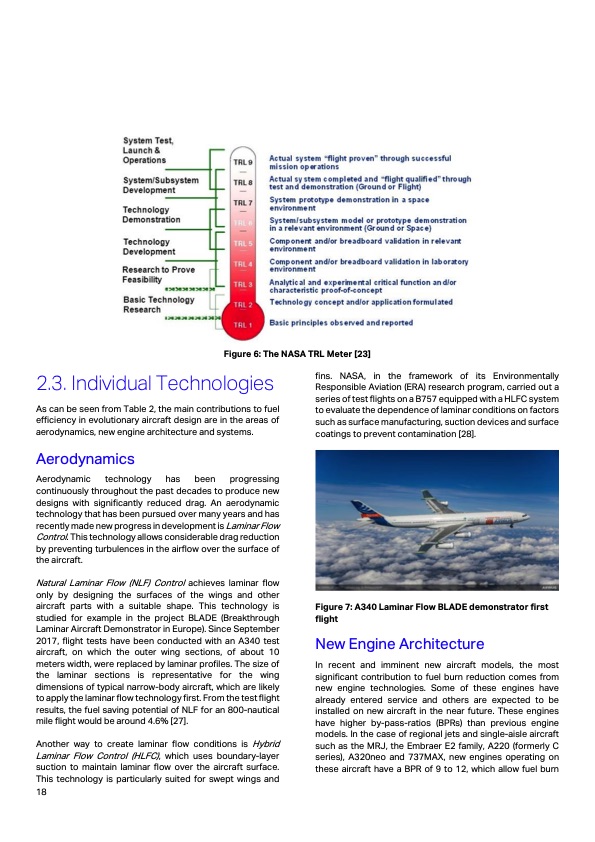
PDF Publication Title:
Text from PDF Page: 018
2.3. Individual Technologies As can be seen from Table 2, the main contributions to fuel efficiency in evolutionary aircraft design are in the areas of aerodynamics, new engine architecture and systems. Aerodynamics Aerodynamic technology has been progressing continuously throughout the past decades to produce new designs with significantly reduced drag. An aerodynamic technology that has been pursued over many years and has recently made new progress in development is Laminar Flow Control. This technology allows considerable drag reduction by preventing turbulences in the airflow over the surface of the aircraft. Natural Laminar Flow (NLF) Control achieves laminar flow only by designing the surfaces of the wings and other aircraft parts with a suitable shape. This technology is studied for example in the project BLADE (Breakthrough Laminar Aircraft Demonstrator in Europe). Since September 2017, flight tests have been conducted with an A340 test aircraft, on which the outer wing sections, of about 10 meters width, were replaced by laminar profiles. The size of the laminar sections is representative for the wing dimensions of typical narrow-body aircraft, which are likely to apply the laminar flow technology first. From the test flight results, the fuel saving potential of NLF for an 800-nautical mile flight would be around 4.6% [27]. Another way to create laminar flow conditions is Hybrid Laminar Flow Control (HLFC), which uses boundary-layer suction to maintain laminar flow over the aircraft surface. This technology is particularly suited for swept wings and 18 fins. NASA, in the framework of its Environmentally Responsible Aviation (ERA) research program, carried out a series of test flights on a B757 equipped with a HLFC system to evaluate the dependence of laminar conditions on factors such as surface manufacturing, suction devices and surface coatings to prevent contamination [28]. Figure 7: A340 Laminar Flow BLADE demonstrator first flight New Engine Architecture In recent and imminent new aircraft models, the most significant contribution to fuel burn reduction comes from new engine technologies. Some of these engines have already entered service and others are expected to be installed on new aircraft in the near future. These engines have higher by-pass-ratios (BPRs) than previous engine models. In the case of regional jets and single-aisle aircraft such as the MRJ, the Embraer E2 family, A220 (formerly C series), A320neo and 737MAX, new engines operating on these aircraft have a BPR of 9 to 12, which allow fuel burn Figure 6: The NASA TRL Meter [23]PDF Image | Aircraft Technology Roadmap to 2050

PDF Search Title:
Aircraft Technology Roadmap to 2050Original File Name Searched:
tech-roadmap-aircraft-2050.pdfDIY PDF Search: Google It | Yahoo | Bing
NFT (Non Fungible Token): Buy our tech, design, development or system NFT and become part of our tech NFT network... More Info
IT XR Project Redstone NFT Available for Sale: NFT for high tech turbine design with one part 3D printed counter-rotating energy turbine. Be part of the future with this NFT. Can be bought and sold but only one design NFT exists. Royalties go to the developer (Infinity) to keep enhancing design and applications... More Info
Infinity Turbine IT XR Project Redstone Design: NFT for sale... NFT for high tech turbine design with one part 3D printed counter-rotating energy turbine. Includes all rights to this turbine design, including license for Fluid Handling Block I and II for the turbine assembly and housing. The NFT includes the blueprints (cad/cam), revenue streams, and all future development of the IT XR Project Redstone... More Info
Infinity Turbine ROT Radial Outflow Turbine 24 Design and Worldwide Rights: NFT for sale... NFT for the ROT 24 energy turbine. Be part of the future with this NFT. This design can be bought and sold but only one design NFT exists. You may manufacture the unit, or get the revenues from its sale from Infinity Turbine. Royalties go to the developer (Infinity) to keep enhancing design and applications... More Info
Infinity Supercritical CO2 10 Liter Extractor Design and Worldwide Rights: The Infinity Supercritical 10L CO2 extractor is for botanical oil extraction, which is rich in terpenes and can produce shelf ready full spectrum oil. With over 5 years of development, this industry leader mature extractor machine has been sold since 2015 and is part of many profitable businesses. The process can also be used for electrowinning, e-waste recycling, and lithium battery recycling, gold mining electronic wastes, precious metals. CO2 can also be used in a reverse fuel cell with nafion to make a gas-to-liquids fuel, such as methanol, ethanol and butanol or ethylene. Supercritical CO2 has also been used for treating nafion to make it more effective catalyst. This NFT is for the purchase of worldwide rights which includes the design. More Info
NFT (Non Fungible Token): Buy our tech, design, development or system NFT and become part of our tech NFT network... More Info
Infinity Turbine Products: Special for this month, any plans are $10,000 for complete Cad/Cam blueprints. License is for one build. Try before you buy a production license. May pay by Bitcoin or other Crypto. Products Page... More Info
| CONTACT TEL: 608-238-6001 Email: greg@infinityturbine.com | RSS | AMP |